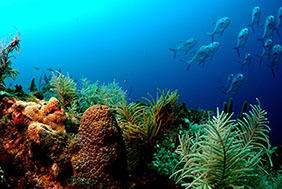Featured Archive - 2013 Publications
Below is a sampling of publications generated by NOAA's coral ecosystem activities in 2013. To access a complete list of NOAA coral ecosystem related publications, use the CoRIS Geoportal
(https://coris.noaa.gov/geoportal/) search tool.
The NOAA Coral Reef Conservation Program (CRCP) Ocean Acidification Science Plan is intended to guide NOAA funded coral reef ecosystem OA research for 2012-2016, including research conducted through extramural partners, grants and contracts. The plan covers all shallow coral reef ecosystems under the jurisdiction of the United States (U.S.) and Pacific Freely Associated States (PFAS), and outlines national research needed to address the many management challenges for reducing threats, reversing declines and promoting the resilience of coral reef ecosystems. The priority areas detailed in the plan are responsive to numerous legislative requirements including the Federal Ocean Acidification Research and Monitoring Act of 2009 (Public Law 111-11) and the National Ocean Policy Executive Order (July 2010), and align with broader NOAA strategic documents including the NOAA Ocean and Great Lakes Acidification Research Plan and the NOAA Next Generation Strategic Plan.
This report contains a chemical and biological characterization of sediments from the St. Thomas East End Reserves (STEER) in St. Thomas, U.S. Virgin Islands (USVI). The STEER ManagementPlan (published in 2011) identified chemical contaminants and habitat loss as high or very high threats and called for a characterization of chemical contaminants as well as anassessment of their effects on natural resources. The baseline information contained in this report on chemical contaminants, toxicity and benthic infaunal community composition can be used to assess current conditions, as well as the efficacy of future restoration activities.
This report is the second in a series from a project to assess land-based sources of pollution (LBSP) and effects in the St. Thomas East End Reserves (STEER) in St. Thomas, USVI, and is the result of a collaborative effort between NOAA's National Centers for Coastal Ocean Science, the USVI Department of Planning and Natural Resources, the University of the Virgin Islands, and The Nature Conservancy. Passive water samplers (POCIS), developed by by the US Geological Survey (USGS) as a tool to detect the presence of water soluble contaminants in the environment, were deployed at five locations in the STEER in February 2012. In addition to the February 2012 deployment, the results from an earlier POCIS deployment in May 2010 in Turpentine Gut, a perennial freshwater stream which drains to the STEER, are also reported.
The Southeast Florida Coral Reef Initiative (SEFCRI) Local Action Strategy identified threats to the coral reef system in Miami-Dade, Broward, Palm Beach and Martin Counties, and targets four key focus areas: Land Based Sources of Pollution (LBSP), Fishing Diving and Other Uses, Awareness and Appreciation, and Maritime Industry Coastal Construction Impacts. This report addresses the LBSP Local Action Strategy Project 21 � Evaluate the outcomes of LBSP Project 3 and 19 to identify gaps in best management practices. Specifically, it provides a preliminary overview of the programs already in place to reduce LBSP, and makes initial recommendations for improving both state and local programs that affect coral reef habitat.
The report highlights product development areas using NOAA satellite remote sensing and analyzes their applicability to the Coral Program National and International Goals & Objectives for coral reef management and the U.S. jurisdictional coral reef management priorities. It also highlights remote sensing product development areas that best correlate with needs identified in these documents and that can best inform coral reef resource management in the next few years. The report concludes with a set of recommendations for product development areas the Coral Program should pursue.
In the following technical memorandum, techniques and procedures are presented to assist
researchers in developing small experimental systems for coral and attempts to identify
possible confounding factors to consider when setting up laboratory experiments with coral.
The system features presented here are intended for relatively simple experiments when funding, space, and time (i.e., experimental duration from days to one or two months) are
limiting. While focused on scleractinian coral, often referred to as stony or hard coral, the
following information can be applicable to studies involving other cnidarian model organisms,
such as anemones (Order Actiniaria) or soft coral (Order Alcyonacea).
This report provides an overview of CRW's operational twice-weekly 0.5 degree (approximately 50 km spatial resolution) satellite coral bleaching thermal stress monitoring product suite, representing CRW's heritage product suite and the core of CRW's current DSS for much of the last decade, along with some experimental products and a major enhancement associated with the operational product suite. CRW's products are disseminated and delivered through various mechanisms and formats to satisfy different user needs and backgrounds.


